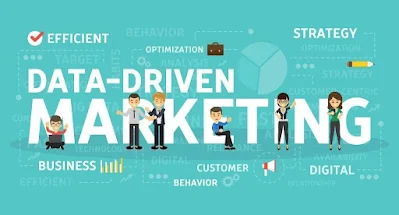Data-Driven Forecasting
The Cornerstone of Realistic Goal Setting and Proactive Resource Allocation in Digital Marketing

Trends in Marketing
In the dynamic realm of
digital marketing, where trends shift rapidly and consumer behavior is
constantly evolving, accurate forecasting is no longer a luxury—it's a
necessity. The ability to predict future performance with a reasonable degree
of certainty is the cornerstone of effective resource allocation and the
establishment of realistic, achievable goals.
Unlike traditional marketing approaches that often rely on intuition and guesswork, data-driven forecasting leverages the power of analytics to provide a clearer picture of potential outcomes, empowering marketers to make informed decisions and optimize their campaigns for maximum impact. This strategic approach allows for proactive resource management, minimizing waste and
 |
| Data Driven Marketing Strategy |
maximizing the return on investment (ROI) for every marketing initiative.
Data-driven forecasting
starts with the meticulous collection and analysis of relevant historical data.
This involves gathering information from various sources, including website
analytics, social media engagement metrics, email marketing performance, and
sales data. By analyzing these datasets, marketers can identify trends,
patterns, and seasonality in customer behavior, providing valuable insights
into future performance. 
The Future of Marketing
This historical analysis forms the bedrock of any
effective forecasting model, providing a foundation upon which future
projections can be built. However, simply looking at 
The Benefits of Data-Driven Management for Revenue Optimization
past performance isn't
sufficient; a robust forecasting model incorporates predictive analytics,
utilizing algorithms to identify emerging trends and anticipate future shifts
in consumer behavior.
Predictive analytics go beyond simply extrapolating past trends. They incorporate external factors, such as economic indicators, market competition, and seasonal influences, to create more comprehensive and nuanced predictions. These models can account for unexpected events or changes in the market, providing a more adaptable and resilient forecasting system.
 |
| Steps in Data Driven Strategies |
The benefits of
data-driven forecasting extend far beyond accurate predictions. By providing a
clear picture of anticipated performance, it allows marketers to set realistic
and achievable goals. Instead of setting arbitrary targets based on guesswork,
marketers can align their goals with data-driven projections, ensuring that
their objectives are both ambitious and attainable. This fosters a sense of
accountability and provides a framework for measuring success, allowing
marketers to track their progress against concrete targets and make necessary
adjustments along the way. Setting realistic goals also boosts team morale and
enhances overall productivity, as the team works towards clearly defined and
achievable objectives.
Perhaps the most
significant advantage of data-driven forecasting is its impact on resource
allocation. By accurately predicting future performance, marketers can allocate
resources more efficiently, maximizing the ROI of their investments. 
More Marketing Strategy
Instead of
spreading resources thinly across various campaigns, they can prioritize
initiatives with the highest potential for success, ensuring that every dollar
invested yields optimal results. This proactive approach minimizes waste,
allowing marketers to focus on high-impact activities and optimize their
campaigns for maximum effectiveness. This strategic allocation of resources is
particularly crucial in competitive markets, where efficient resource
management can determine the success or failure of a marketing campaign.
In conclusion, data-driven forecasting is not merely a tool for predicting future performance; it’s a strategic approach that empowers marketers to set realistic goals, allocate resources efficiently, and ultimately, optimize their campaigns for maximum impact.
By leveraging the power of analytics and predictive modeling, marketers can move beyond guesswork and embrace a more precise, data-informed approach to their work.
This strategic shift from reactive to proactive management is crucial for success in the dynamic and ever-changing landscape of digital marketing, ensuring that every marketing initiative is aligned with realistic expectations and optimized for maximum return on investment. The ability to accurately forecast future performance is the key to unlocking the full potential of any digital marketing strategy.





Comments
Post a Comment
tyropjamenya@gmail.com